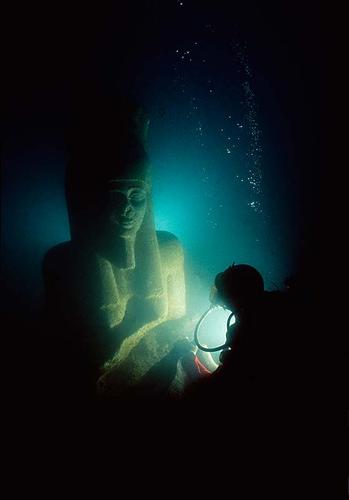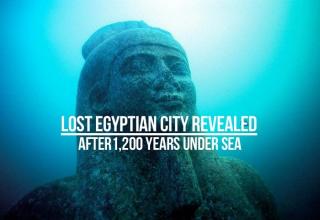The Sunken City of Heracleion
wardnate77
Published
10/18/2013
Amazing things found in the underwater city of Heracleion
- List View
- Player View
- Grid View
Advertisement
-
1.

-
2.
 Franck Goddio and divers of his team are inspecting the statue of a pharaoh. The colossal statue is of red granite and measures over 5 metres. It was found close to the big temple of sunken Heracleion.
Franck Goddio and divers of his team are inspecting the statue of a pharaoh. The colossal statue is of red granite and measures over 5 metres. It was found close to the big temple of sunken Heracleion. -
3.
 Head of a colossal statue of red granite 5.4 m representing the god Hapi, which decorated the temple of Heracleion. The god of the flooding of the Nile, symbol of abundance and fertility, has never before been discovered at such a large scale, which points to his importance for the Canopic region.
Head of a colossal statue of red granite 5.4 m representing the god Hapi, which decorated the temple of Heracleion. The god of the flooding of the Nile, symbol of abundance and fertility, has never before been discovered at such a large scale, which points to his importance for the Canopic region. -
4.
 Franck Goddio and his team with a colossal statue of red granite 5.4 m representing the god Hapi, which decorated the temple of Heracleion. The god of the flooding of the Nile, symbol of abundance and fertility, has never before been discovered at such a large scale, which points to his importance for the Canopic region.
Franck Goddio and his team with a colossal statue of red granite 5.4 m representing the god Hapi, which decorated the temple of Heracleion. The god of the flooding of the Nile, symbol of abundance and fertility, has never before been discovered at such a large scale, which points to his importance for the Canopic region. -
5.
 On a barge the colossal triade of the temple of Heracleion has been raised together with the assembled fragments of a huge stele. The pharaoh, the queen and the god Hapi are represented in red granite. All about 5 meters high, dated to the 4th century B.C. The red granite stele found in 17 pieces is assembled. It dates from the 2nd century B.C.
On a barge the colossal triade of the temple of Heracleion has been raised together with the assembled fragments of a huge stele. The pharaoh, the queen and the god Hapi are represented in red granite. All about 5 meters high, dated to the 4th century B.C. The red granite stele found in 17 pieces is assembled. It dates from the 2nd century B.C. -
6.
 This gold object 11 x 5 cm was found during the preliminary exploration of the southern sector of Heracleion. It is engraved with a Greek text of five and a half lines. It is an example of a plaque that act as a signature for foundation deposits in the name of the king, Ptolemy III 246222 BC, responsible for building.
This gold object 11 x 5 cm was found during the preliminary exploration of the southern sector of Heracleion. It is engraved with a Greek text of five and a half lines. It is an example of a plaque that act as a signature for foundation deposits in the name of the king, Ptolemy III 246222 BC, responsible for building. -
7.
 Bronze statue of Osiris, the assassinated and resurrected king-god. It is adorned with the atef crown. The typical insignia of power crook and flail are missing. Its open eyes are accentuated by fine gold sheets.
Bronze statue of Osiris, the assassinated and resurrected king-god. It is adorned with the atef crown. The typical insignia of power crook and flail are missing. Its open eyes are accentuated by fine gold sheets. -
8.
 An archaeologist measures the feet of a colossal red granite statue at the site of Heracleion discovered in Aboukir Bay.
An archaeologist measures the feet of a colossal red granite statue at the site of Heracleion discovered in Aboukir Bay. -
9.
 Bronze oil lamp late Hellenistic period, about 2nd century BC discovered in the temple of Amun.
Bronze oil lamp late Hellenistic period, about 2nd century BC discovered in the temple of Amun. -
10.
 Franck Goddio with the intact and inscribed Heracleion stele 1.90 m. It was commissioned by Nectanebo I 378-362 BC and is almost identical to the Naukratis Stele in the Egyptian Museum in Cairo. The place where it was to be situated is clearly named: Thonis-Heracleion.
Franck Goddio with the intact and inscribed Heracleion stele 1.90 m. It was commissioned by Nectanebo I 378-362 BC and is almost identical to the Naukratis Stele in the Egyptian Museum in Cairo. The place where it was to be situated is clearly named: Thonis-Heracleion. -
11.
 The stele of Heracleion 1.90m had been ordered by Pharaoh Nectanebo I 378-362 BC and is almost identical to the stele of Naukratis in the Egyptian Museum of Cairo. The place where it was supposed to be erected is explicitly mentioned: Thonis-Heracleion.
The stele of Heracleion 1.90m had been ordered by Pharaoh Nectanebo I 378-362 BC and is almost identical to the stele of Naukratis in the Egyptian Museum of Cairo. The place where it was supposed to be erected is explicitly mentioned: Thonis-Heracleion. -
12.
 Franck Goddio is inspecting a stone with gold fragments 6th-2nd century BC.
Franck Goddio is inspecting a stone with gold fragments 6th-2nd century BC. -
13.
 A gold vessel Phiale recovered from Thonis-Heracleion. Phiale were shallow dishes used throughout the Hellenistic world for drinking and pouring libations.
A gold vessel Phiale recovered from Thonis-Heracleion. Phiale were shallow dishes used throughout the Hellenistic world for drinking and pouring libations. -
14.
 One of the finest finds from the bay of Aboukir is a remarkable Graeco-Egyptian product of the Ptolemaic era a statue of a Ptolemaic queen in dark stone wearing the usual robe that identifies the sovereigns of Isis incarnate. Found at the site of Heracleion, the statue is certainly one of the queens of the Ptolemaic dynasty. Most likely, a representation of Cleopatra II or Cleopatra III, dressed as goddess Isis.
One of the finest finds from the bay of Aboukir is a remarkable Graeco-Egyptian product of the Ptolemaic era a statue of a Ptolemaic queen in dark stone wearing the usual robe that identifies the sovereigns of Isis incarnate. Found at the site of Heracleion, the statue is certainly one of the queens of the Ptolemaic dynasty. Most likely, a representation of Cleopatra II or Cleopatra III, dressed as goddess Isis. -
15.
 Colossus of a Ptolemaic queen made out of red granite. The whole statue measures 490 cm in height and weighs 4 tons. It was found close to the big temple of sunken Heracleion.
Colossus of a Ptolemaic queen made out of red granite. The whole statue measures 490 cm in height and weighs 4 tons. It was found close to the big temple of sunken Heracleion. -
16.

-
17.
 A colossal statue of red granite 5.4 m representing the god Hapi, which decorated the temple of Heracleion. The god of the flooding of the Nile, symbol of abundance and fertility, has never before been discovered at such a large scale, which points to his importance for the Canopic region.
A colossal statue of red granite 5.4 m representing the god Hapi, which decorated the temple of Heracleion. The god of the flooding of the Nile, symbol of abundance and fertility, has never before been discovered at such a large scale, which points to his importance for the Canopic region. -
18.
 A colossal statue of red granite 5.4 m representing the god Hapi, which decorated the temple of Heracleion. The god of the flooding of the Nile, symbol of abundance and fertility, has never before been discovered at such a large scale, which points to his importance for the Canopic region.
A colossal statue of red granite 5.4 m representing the god Hapi, which decorated the temple of Heracleion. The god of the flooding of the Nile, symbol of abundance and fertility, has never before been discovered at such a large scale, which points to his importance for the Canopic region. -
19.
 One of the finest finds from the bay of Aboukir is a remarkable Graeco-Egyptian product of the Ptolemaic era a statue of a Ptolemaic queen in dark stone. Found at the site of Heracleion, the statue is certainly one of the queens of the Ptolemaic dynasty. Most likely, a representation of Cleopatra II or Cleopatra III, dressed as goddess Isis.
One of the finest finds from the bay of Aboukir is a remarkable Graeco-Egyptian product of the Ptolemaic era a statue of a Ptolemaic queen in dark stone. Found at the site of Heracleion, the statue is certainly one of the queens of the Ptolemaic dynasty. Most likely, a representation of Cleopatra II or Cleopatra III, dressed as goddess Isis. -
20.

-
21.
 A colossal statue of red granite 5.4 m representing the god Hapi, which decorated the temple of Heracleion. The god of the flooding of the Nile, symbol of abundance and fertility, has never before been discovered at such a large scale, which points to his importance for the Canopic region.
A colossal statue of red granite 5.4 m representing the god Hapi, which decorated the temple of Heracleion. The god of the flooding of the Nile, symbol of abundance and fertility, has never before been discovered at such a large scale, which points to his importance for the Canopic region. -
22.
 Head of a pharaoh statue is raised to the surface. The colossal statue is of red granite and measures over 5 metres. It was found close to the big temple of sunken Heracleion.
Head of a pharaoh statue is raised to the surface. The colossal statue is of red granite and measures over 5 metres. It was found close to the big temple of sunken Heracleion. -
23.
 Bronze statuette of pharaoh of the 26th dynasty, found at the temple of Amon area at Heracleion. The sovereign wears the blue crown probably the crown of the accession. His dress is extremely simple and classical: the bare-chested king wears the traditional shendjyt kilt or loincloth.
Bronze statuette of pharaoh of the 26th dynasty, found at the temple of Amon area at Heracleion. The sovereign wears the blue crown probably the crown of the accession. His dress is extremely simple and classical: the bare-chested king wears the traditional shendjyt kilt or loincloth.
23/23
1/23








3 Comments